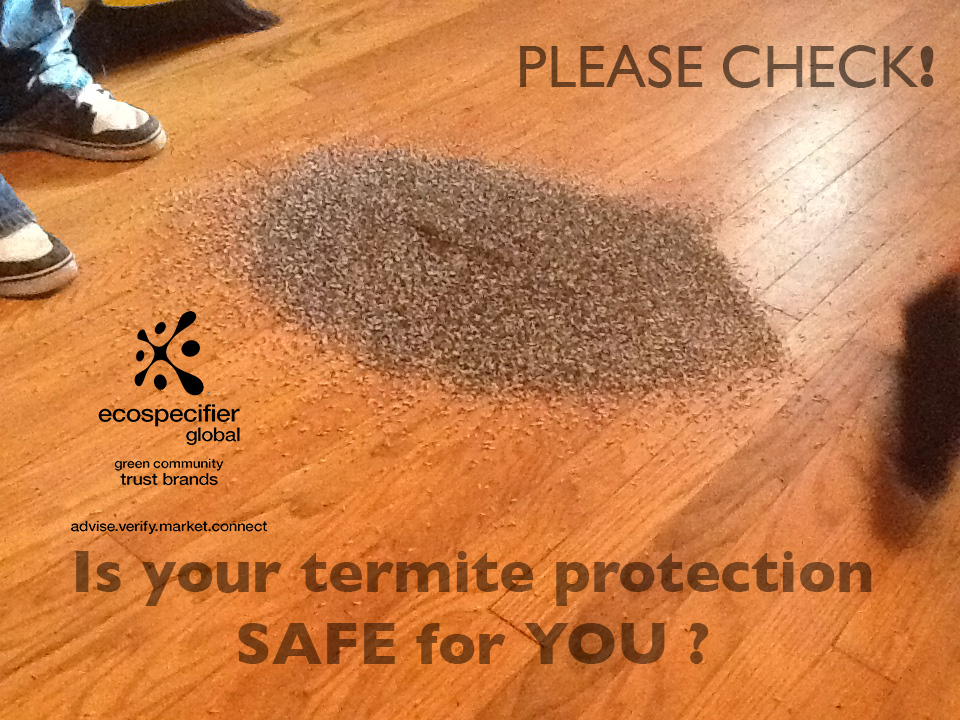Termites (commonly known as white ants) are an important part of the natural ecosystem, but in buildings they are pests. In nature, they primarily feed on detritus in the form of leaf litter, soil and dead wood, the very same wood that may be the dominant building material for your home and herein lays the problem.
Termites can and will readily destroy your home if it contains timber and it is left unprotected. Termites are found all over Australia with high incidences occurring in all major urban centres.
Sadly many of the chemicals that are used to control termite infestations can put your family’s health in danger if they are not installed properly and used discretely. Even many of the chemicals that are approved as ‘safe to use’ have health impacts that even many licensed applicators are unaware of.
Pesticides for the use of preventative termite control are covered by the Australian Standard AS 3660.1 (2000) and 3660.2 (2000) for remedial termite control.
Some approved pesticides for termite control include:
- Arsenic Trioxide –
- Very high acute toxicity, known carcinogen, developmental or reproductive toxin and suspected Endocrine (hormone) disruptor.
- Symptoms include (but are not limited to): Cancer, a metallic taste in the mouth, vomiting, muscle weakness, lethargy, liver damage (e.g. jaundice), shock and cardiac arrhythmia
- Chlorpyrifos and other organo-phospates;
- Moderate acute toxicity, Cholinesterase (nervous system) inhibitor and suspected Endocrine disruptor.
- Symptoms include (but are not limited to): Diarrhoea, nausea, vomiting, convulsions, dizziness, excessive salivation, and blurred vision.
- Bifenthrin and other synthetic pyrethroids (derived originally from the daisy plant)
- Moderate acute toxicity, developmental or reproductive toxin, possible carcinogen and suspected Endocrine disruptor.
- Symptoms include ( but are not limited to): Headaches, fatigue, vomiting, abnormal facial sensations, muscle twitching and seizures.
- Moderate acute toxicity, developmental or reproductive toxin, possible carcinogen and suspected Endocrine disruptor.
- Moderate acute toxicity, Cholinesterase (nervous system) inhibitor and suspected Endocrine disruptor.
- Very high acute toxicity, known carcinogen, developmental or reproductive toxin and suspected Endocrine (hormone) disruptor.
Ecospecifier has a vision for an ecologically aware built environment for Australia where toxins have no place where they can affect people or the broader environment. This is why we developed the Ecospecifier Cautionary Assessment Process (ESCAP), to assess chemicals and their risk and enable us to use the best scientific knowledge to determine whether chemicals used in products like termite control are safe or should be excluded for use if they are deemed to have significant health and/or ecological impacts.
An example how ESCAP results in safe use of chemicals with low risk profiles can be seen in the TRITHOR Termite Protection System (Ensystex Australasia) and JIHONG termite barrier films, both effective hybrid physical/chemical barriers providing all the benefits of both physical and chemical barriers but with the chemicals locked between layers of impervious plastic.
Controlling termites does not need to infringe upon your health and this is where Ecospecifier can help both you and your loved ones. For more information, check out http://www.ecospecifier.com.au.
Explore more about the product ranges that have been eco-certified and listed by Ecospecifier, by using the Product Search Engine on Ecospecifier Global: http://www.ecospecifier.com.au
Join us in more conversations about green products and sustainability issues on our social media pages:
Follow Ecospecifier on Facebook
Follow Ecospecifier on Twitter
Follow Ecospecifier on LinkedIn
Join our Social Media Honour Roll – support the switch to green products
Like, Comment and Share our blogs and posts on your social media pages … and we will send your name out to more than 15,000 subscribers via our monthly Ecospecifier Global Newsletter.
See which stellar individuals, businesses and networks made the latest Honour Roll on Twitter and Facebook HERE We salute you in helping us educate and help more people #MaketheSwitch to #EcoResponsible products.



